温州蜜柑
| 温州蜜柑 | |
|---|---|
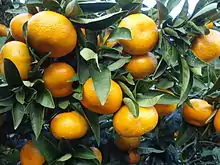 | |
| 科学分类 | |
| 界: | 植物界 Plantae |
| 演化支: | 被子植物 Angiosperms |
| 演化支: | 真双子叶植物 Eudicots |
| 演化支: | 蔷薇类植物 Rosids |
| 目: | 无患子目 Sapindales |
| 科: | 芸香科 Rutaceae |
| 属: | 柑橘属 Citrus |
| 种: | 温州蜜柑 C. unshiu |
| 二名法 | |
| Citrus unshiu (Swingle) Marcow.[1] | |
分類
田中長三郎的分類法將溫州蜜柑與橘劃分爲不同物種,而沃爾特·譚尼森·施永高的分類法視溫州蜜柑爲橘的變種。[6]遺傳分析表明,溫州蜜柑是高度自交的橘柚雜交種,其基因組有22%來自柚,多於大多數橘。其由含柚基因組少的黃陵廟或紀州變種(田中分類法爲柑橘屬橘種)同柚或其雜交種雜交,然後將所得品種與前者的另一種回交而得。[7][8]
特徵
溫州蜜柑是極爲甘甜的柑橘品種。[9]其通常無籽,大小與其他橘種相似。果皮鬆散,呈皮革狀,比其他柑橘易剝。[10]外皮通常光滑或略粗糙,呈中小型扁平體球狀。[11][12]通常有10至12個易分離、有韌膜的部分。[12]肉質脆弱。[10]果皮顏色通常取決於氣候,潮溼地區成熟時可能仍是綠色,夜晚涼爽地區成熟時橙裏透紅。[12][13]
溫州蜜柑耐寒,較冷地區果實在較冷時會更甜。成熟植株可在–9℃乃至–11℃的環境中存活數小時。[14]可食用柑橘品種中,只有金橘更耐寒。溫州蜜柑少有刺,因此受人歡迎。[12]可用種子種植,首次結果大約需8年,也可嫁接至其他柑橘類砧木,如枳。[12]
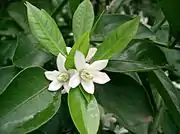
花、葉
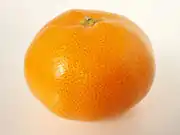
成熟果實
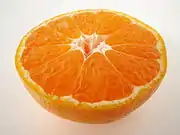
果實水平斷面
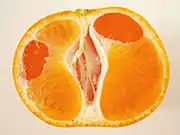
果實垂直斷面

果皮內的房
歷史
溫州蜜柑原產於中国大陆,唐代作為貢品,南宋韩世忠之子韓彥直曾於瑞安府任时著《橘錄校注》(又稱《永嘉橘錄》《橘錄》)系統介紹其品種與種植。明朝永乐年間日本僧人智惠將其帶回九州鹿兒島。1878年美國派日本特使罗伯特·布鲁斯·范·瓦尔肯堡將軍夫人以日本產地薩摩(/ Satsuma)名之[15]。臺灣北部於日治時期由日本內地引進,亦有種植。
參考文獻
- 米倉浩司; 梶田忠. . 和名-学名インデックス(YList). 2003 [2020-06-08].
- Schlegel, Rolf. 2nd. CRC Press. 2009: 437. ISBN 9781439802434.
It's named after, Unsyu, China; in Japan it is known as "unshu mikan," in China, as "wenzhou migan"; recorded cultivation of the "wenzhou migan" date back some 2,400 years; it was listed as a tribute item for Imperial consumption in the TANG Dynasty; the best record of the cultivation of this variety in ancient China is from Jijia Julu, written by Han YAN, the governor of the region and published in 1178
- . hawaii.edu.
Mikan is a tangerine-like citrus fruit that is grown in warmer regions of Japan in large quantities. Many different varieties have been introduced to Japan from China since the eighth century, but since the late 19th century the most important variety has been the unshu.
- . Germplasm Resources Information Network (GRIN). USDA. [2017-12-11]. "probable origin in Kyushu islands, Japan or imported from China to Japan."
- Misaki, Akira. . 經濟理論 (University of Wakayama). November 1999, 292: 97–118. (原始内容存档于2001-01-10) (日语).
(After the many years of research, Dr. Tanaka has concluded the place of origin of Satsuma is Nagashima, Kagoshima. Satsuma is a chance seedling of Sōkitsu, Mankitsu, or Tendaisankitsu introduced from Huangyan Zhejiang, China. It appeared in the early Edo period.)
- Froelicher, Yann; Mouhaya, Wafa; Bassene, Jean-Baptiste; Costantino, Gilles; Kamiri, Mourad; Luro, Francois; Morillon, Raphael; Ollitrault, Patrick. . Tree Genetics & Genomes. 2011, 7: 49–61. doi:10.1007/s11295-010-0314-x.
- Wu, Guohong Albert; Terol, Javier; Ibanez, Victoria; López-García, Antonio; Pérez-Román, Estela; Borredá, Carles; Domingo, Concha; Tadeo, Francisco R; Carbonell-Caballero, Jose; Alonso, Roberto; Curk, Franck; Du, Dongliang; Ollitrault, Patrick; Roose, Mikeal L. Roose; Dopazo, Joaquin; Gmitter Jr, Frederick G.; Rokhsar, Daniel; Talon, Manuel. (PDF). Nature. 2018, 554 (7692): 311–316. Bibcode:2018Natur.554..311W. PMID 29414943. doi:10.1038/nature25447. and Supplement
- Shimizu, Tokurou; Kitajima, Akira; Nonaka, Keisuke; Yoshioka, Terutaka; Ohta, Satoshi; Goto, Shingo; Toyoda, Atsushi; Fujiyama, Asao; Mochizuki, Takako; Nagasaki, Hideki; Kaminuma, Eli; Nakamura, Yasukazu. . PLOS ONE. 2016-11-30, 11 (11): e0166969. Bibcode:2016PLoSO..1166969S. PMC 5130255. PMID 27902727. doi:10.1371/journal.pone.0166969. e0166969.
- Elisa Bosley. . CookingLight. [2015-02-25].
- Silvia Bautista-Baños; Gianfranco Romanazzi; Antonio Jiménez-Aparicio. . Elsevier Science. 2016: 76. ISBN 978-0-12-802757-8.
- . citrusvariety.ucr.edu. [2020-04-23].
- Andersen, Peter C.; Ferguson, James J. . University of Florida Electronic Data Information Source. 2019 [2020-04-23].
- P. C. Andersen; J. J. Ferguson; T. M. Spann. . ufl.edu. 2019-04-05.
- . PLANTanswers.
- . [2018-02-22]. (原始内容存档于2018-02-23).
- Saunt, James. 2nd. Norwich, England: Sinclair International Ltd. 2000. ISBN 1872960014. OCLC 45130256.
- Barkley, NA; Roose, ML; Krueger, RR; Federici, CT. . Theoretical and Applied Genetics. 2006, 112 (8): 1519–1531. PMID 16699791. doi:10.1007/s00122-006-0255-9.
- . Citrus Variety Collection. University of California Riverside.
- Kuniaki Sugawara; Atsushi Oowada; Takaya Moriguchi1; Mitsuo Omura. (PDF). HortScience. 1995, 30 (6): 1276–1278. doi:10.21273/HORTSCI.30.6.1276.
This article is issued from Wikipedia. The text is licensed under Creative Commons - Attribution - Sharealike. Additional terms may apply for the media files.
.jpg.webp)